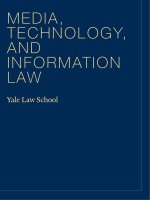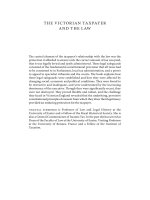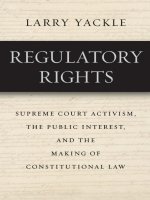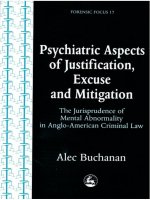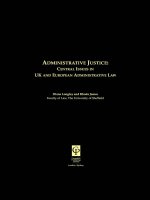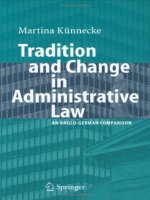Constitutional and Administrative Law doc
Bạn đang xem bản rút gọn của tài liệu. Xem và tải ngay bản đầy đủ của tài liệu tại đây (1.67 MB, 160 trang )
CHRIS TAYLOR
> UNDERSTAND QUICKLY
> REVISE EFFECTIVELY
> TAKE EXAMS WITH CONFIDENCE
Series by Heat design
LAW EXPRESS
CONSTITUTIONAL AND
ADMINISTRATIVE LAW
DO YOU WANT
TO REVISE MORE EFFECTIVELY?
DO YOU WANT TO TAKE EXAMS
WITH CONFIDENCE?
The answer is in your hands.
Law Express helps you to get to the heart of constitutional and administrative
law, ensuring you get the most out of your study time when it really matters.
Law Express: Constitutional and Administrative Law is specifi cally designed to:
• help you understand what is important about the subject
• enable you to remember the most important cases and statutes
• show you how to apply your knowledge effectively in exams
Tried and tested by undergraduate law students across the UK.
You really feel that someone is trying to help you: ‘you’re not alone’! The tone is
approachable, reader-friendly and empathises with the student. It really is a
helping hand.
Sarah Bainbridge, law student
Perfect for the purposes of revision… I think if I used one of these books as a
revision aid, I could improve my mark.
Martin Wilks, law student
Visit www.pearsoned.co.uk/lawexpress for interactive revision support.
> UNDERSTAND QUICKLY
> REVISE EFFECTIVELY
> TAKE EXAMS WITH CONFIDENCE
Law
CONSTITUTIONAL AND ADMINISTRATIVE LAW
CHRIS TAYLOR
CONSTITUTIONAL AND
ADMINISTRATIVE LAW
www.pearson-books.com
£9.99
9781405821919_COVER.indd 1 1/10/07 13:54:35
Constitutional and Administrative Law
Visit the
Law Express Series
Companion Website at
www.pearsoned.co.uk/lawexpress to find valuable student
learning material including:
❚ A Study Plan test to assess how well you know the subject
before you begin your revision
❚ Interactive quizzes to test your knowledge of the main points
from each chapter of the book
❚ Further examination questions and guidelines for answering
them
❚ Interactive flashcards to help you revise the main terms and
cases
❚ Printable versions of the topic maps and checklists
CONS_A01.QXP 1/10/07 14:36 Page i
Other titles in the series are available from your local bookshop
or online at www.pearsoned.co.uk
ISBN: 9781405821957
ISBN: 9781405821940
ISBN: 9781405840217
ISBN: 9781405821919
ISBN: 9781405821933
ISBN: 9781405823579 ISBN: 9781405823586
ISBN: 9781405821926
Understand quickly. Revise effectively.
Take exams with confidence.
ISBN: 9781405847155
CONS_A01.QXP 1/10/07 14:36 Page ii
Constitutional and
Administrative Law
Chris Taylor
CONS_A01.QXP 1/10/07 14:36 Page iii
Pearson Education Limited
Edinburgh Gate
Harlow
Essex CM20 2JE
England
and Associated Companies throughout the world
Visit us on the World Wide Web at:
www.pearsoned.co.uk
First published 2008
© Pearson Education Limited 2008
The right of Chris Taylor to be identified as author of this work has been asserted by him in
accordance with the Copyright, Designs and Patents Act 1988.
All rights reserved. No part of this publication may be reproduced, stored in a retrieval system,
or transmitted in any form or by any means, electronic, mechanical, photocopying, recording or
otherwise, without either the prior written permission of the publisher or a licence permitting
restricted copying in the United Kingdom issued by the Copyright Licensing Agency Ltd, Saffron
House, 6–10 Kirby Street, London EC1N 8TS.
All trademarks used herein are the property of their respective owners. The use of any
trademark in this text does not vest in the author or publisher any trademark ownership rights
in such trademarks, nor does the use of such trademarks imply any affiliation with or
endorsement of this book by such owners.
Crown Copyright material is reproduced with the permission of the Controller of HMSO and the
Queen’s Printer for Scotland
Law Commission Reports are reproduced under the terms of the Click-Use Licence
ISBN: 978-1-4058-2191-9
British Library Cataloguing-in-Publication Data
A catalogue record for this book is available from the British Library
Library of Congress Cataloging-in-Publication Data
Taylor, Christopher W.
Consitutional and administrative law / Chris Taylor.
p. com.
Includes bibliographical references and index.
ISBN 978-1-4058-2191-9 (pbk.)
1. Constitutional law Great Britain. 2. Adminstrative law Great Britain. I. Title.
KD3989.T39 2008
342.41 dc22 2007036917
10987654321
11 10 09 08 07
Typeset by 3 in 10pt Helvetic Condensed
Printed and bound by Henry Ling Ltd., at the Dorset Press, Dorchester, Dorset
The publisher’s policy is to use paper manufactured from sustainable forests.
CONS_A01.QXP 1/10/07 14:36 Page iv
Contents
v
Acknowledgements vii
Introduction viii
Guided tour x
Table of cases and statutes xii
Chapter 1: The constitution of the UK 1
Chapter 2: Where does the constitution come from? 10
Chapter 3: Basic principles of the constitution 25
Chapter 4: Institutions of state 1 41
Chapter 5: Institutions of state 2 53
Chapter 6: Civil liberties and human rights 66
Chapter 7: Freedom of expression and assembly 77
Chapter 8: Police powers 92
Chapter 9: Judicial review 108
Chapter 10: Tribunals, inquiries and ombudsmen 125
And finally, before the exam . . . 134
Glossary of terms 137
Index 140
CONS_A01.QXP 1/10/07 14:36 Page v
vi
Supporting resources
Visit www.pearsoned.co.uk/lawexpress to find valuable online
resources
Companion Website for students
❚ A Study Plan test to assess how well you know the subject before
you begin your revision
❚ Interactive quizzes to test your knowledge of the main points from
each chapter of the book
❚ Further examination questions and guidelines for answering them
❚ Interactive flashcards to help you revise the main terms and cases
❚ Printable versions of the topic maps and checklists
Also: The regularly maintained Companion Website provides the
following features:
❚ Search tool to help locate specific items of content
❚ E-mail results and profile tools to send results of quizzes to
instructors
❚ Online help and support to assist with website usage and
troubleshooting
For more information please contact your local Pearson Education
sales representative or visit www.pearsoned.co.uk/lawexpress
CONS_A01.QXP 1/10/07 14:36 Page vi
Acknowledgements
Our thanks go to all reviewers who contributed to the development of this text,
including students who participated in research and focus groups which helped to
shape the series format.
vii
CONS_A01.QXP 1/10/07 14:36 Page vii
Introduction
Constitutional and administrative law is one of the core subjects required for a
qualifying law degree and so is a compulsory part of undergraduate law
programmes and graduate diploma in law programmes. It is, however, very
different from many of the other core legal subjects because it concentrates
less on legal rules than on the operation of the system itself – in particular,
the operation of the state and the relationship between the state and the
individual.
Constitutional law is often described as being where law meets politics and
there are frequent references to the political process which directly influences
the law which is introduced. Much of the law we work with originates in
Parliament in the form of statute and so we must understand how Parliament
works and how such statutes are produced. Similarly, in order to appreciate
the role played by the common law, we must understand the position of the
courts within the constitution. More importantly, constitutional law considers
how power is exercised by the state and how those in power are held
accountable. This includes the protection of civil liberties and mechanisms for
the individual to challenge the exercise of state power.
It is not uncommon to approach constitutional law for the first time with a
certain amount of uncertainty, especially if politics is not your favourite
subject, but don’t worry. Almost all students find themselves enjoying the
subject more than they expected and your knowledge of how ‘the system’
works will be invaluable in your other legal studies. The most important thing
to remember is that, because we do not have a written constitution, there is no
central set of rules which dictates how the state should operate. Instead, our
constitutional system is a web of principles and customs which often appear
outdated and vague, so this subject can seem disjointed when compared with
other areas of law, but don’t assume that it is just you who doesn’t understand
at first – just remember the basic principles and take a little time to think
about
why
the constitution has evolved into the system we have today.
Remember that this is a revision guide, not a core text, so it can never provide
you with the depth of understanding which you will need to excel in
viii
CONS_A01.QXP 1/10/07 14:36 Page viii
examinations and it will be no substitute for structured reading around the
various topics. What it can do, however, is to focus your revision on the key
areas and highlight those additional points which examiners are looking for.
The single most common failing in constitutional law examinations is that
students write ‘common sense’ answers, without sufficient reference to the
cases and legal principles. We all know (or think we know) what government
or Parliament are, but that is not enough – as in any other area of legal
writing, you need to produce logical, reasoned arguments supported by
relevant authorities if you are to achieve the highest grades.
INTRODUCTION
ix
CONS_A01.QXP 1/10/07 14:36 Page ix
Guided tour
x
Sample questions – Prepare for what
you will be faced with in your exams!
Guidance on structuring strong answers
is provided at the end of the chapter.
41
Institutions of state 1
4
A printable version of this topic map is available from
www.pearsoned.co.uk/lawexpress
Institutions of state 1
The monarch The judiciary
Contempt of court
The executive
Ministerial
responsibility
Devolution
Scotland
Wales
Northern Ireland
Topic maps – Highlight the main points and
allow you to find your way quickly and
easily through each chapter.
Key definition boxes – Make sure you
understand essential legal terms.
Federal constitution. A constitution which has a division of powers between the
central government and the government of individual states or regions.
Unitary constitution. A constitution with power concentrated in central
government. Local government may exist but not with the constitutional status of
the states under a federal constitution.
KEY DEFINITIONS
Revision checklist – How well do you know
each topic? Don’t panic if you don’t know
them all, the chapters will help you
revise each point so that you
will be fully prepared for
your exams.
Sample question
Could you answer this question? Below is a typical problem question that could arise
on this topic. Guidelines on answering the question are included at the end of this
chapter, whilst a sample essay question and guidance on tackling it can be found on
the companion website.
Introduction
4 INSTITUTIONS OF STATE 1
Revision Checklist
What you need to know:
The constitutional position of the monarch as a hea
largely symbolic powers in relation to the operation
The importance within the constitution of the indep
act to protect the individual from abuse of state pow
The function and forms of contempt of court as a m
administration of justice
The composition and function of the executive and
the state and its ministers (including the process of
The development of ministerial responsibility as a c
CONS_A01.QXP 1/10/07 14:36 Page x
GUIDED TOUR
xi
Problem area ‘Rights’ vs ‘freedoms’
The distinction between ‘rights’ and ‘freedoms’ has been an important one. Examiners
will credit an understanding of the distinction between the two and the different legal
implications of each. In this way, be sure to emphasise the difference between a
‘right’, which can be claimed, and a ‘freedom’, which exists only until the state
removes it.
KEY STATUTES
Human Rights Act 1998, section 6(1)
It is unlawful for a public authority to act in a way w
a Convention right.
Glossary of terms
The glossary is divided into two parts: key definitions and other useful terms.
The key definitions can be found within relevant chapters as well as at the end
o
book. These are the essential terms that you must know and understand in orde
prepare for an examination or a piece of coursework.
The other useful terms provide definitions of other terms and phrases which yo
encounter in this subject and may have forgotten the meaning of. These terms a
highlighted in the text as they occur but the definition can only be found here.
Make sure to point out that many written constitutions are produced after a
revolution, where the citizens rise up against what they see as an oppressive
state. In this way the US constitution was written after the War of Independence
from Britain and the French constitution was produced after the French
Revolution. You can also make the point that, although most countries have a
written constitution, the UK is not the only country without such a document.
Both New Zealand and Israel also have unwritten constitutions.
EXAM TIP
Problem area boxes – Highlight areas
where students most often trip up in exams.
Use them to make sure you do not
make the same mistakes.
Glossary – Forgotten the meaning of a
word? Where a word is highlighted in the
text, turn to the glossary at the back of the
book to remind yourself of its meaning.
Key case and key statutes
boxes – Identify the essential
cases and statutes that you need
to know for your exams.
Further thinking boxes – Illustrate areas of
academic debate, and point you towards
that extra reading required for the top
grades.
Exam tips – Want to impress examiners?
These indicate how you can improve your
exam performance and your chances of
getting top marks.
Any discussion of the role of judicial review allows you to introduce references to
a number of different aspects of constitutional law. For example, as judicial
review is a mechanism for the judiciary to exert control over the executive, it can
be viewed as part of the ‘separation of powers’. Similarly, as judicial review is
limited to secondary legislation (which is not debated in Parliament), it can be
seen to provide a safeguard to ensure that such delegated powers are not
misused.
REVISION NOTE
Revision notes – Highlight points that you
should be aware of in other topic areas, or
where your course may adopt a specific
approach that you should check with your
course tutor before reading further.
6 CIVIL LIBERTIES AND HUMAN RIG
R (on the application of H)
v.
L
Review Tribunal
[2001] QB 1
Concerning: compatibility of do
Human Rights
Facts
H was detained in a mental hos
applied to the tribunal to be rele
tribunal that the conditions for d
application was refused, H soug
Legal principle
It was held that the requiremen
KEY CASE
The wording of the caution emphasises that a suspect who does not mention
information when questioned, but who later seeks to rely on that information as
part of their defence in court may find the court drawing an ‘adverse inference’
from their failure to provide the information earlier (i.e. concluding that they are
lying). This undermines the ‘right to silence’, which was seen as a fundamental
right of the accused and was introduced by the Criminal Justice and Public Order
Act 1994. This change was highly criticised and continues to cause argument and
concern. See Leng (2001).
FURTHER THINKING
CONS_A01.QXP 1/10/07 14:36 Page xi
Table of cases and
statutes
xii
Cases
Agricultural, Horticultural and Forestry
Industry Training Board
v.
Aylesbury
Mushrooms Ltd
[1972] 1 All ER 280
119
Anisminic Ltd
v.
Foreign Compensation
Commission
[1969] 1 All ER 208 123
Associated Provincial Picture Houses Ltd
v.
Wednesbury Corporation
[1948] 1
KB 223 117
Attorney General
v.
De Keyser’s Royal
Hotel Ltd
[1920] AC 508 20, 135
Attorney General
v.
Fulham Corporation
[1921] 1 Ch 440 115
Barnard
v.
National Dock Labour Board
[1953] 2 QB 18 117
BBC
v.
Johns
(Inspector of Taxes) [1965]
Ch 32 19
Bradlaugh
v.
Gossett
(1884) 12 QBD 271
60
British Railways Board
v.
Pickin
[1974]
AC 765 37
Calder (John) (Publications) Ltd
v.
Powell
[1965] 1 QB 509 81
Christie
v.
Leachinsky
[1947] AC 573
102
Congreve
v.
Home Office
[1976] QB 629
16
Council of Civil Service Unions
v.
Minister for the Civil Service
[1985] AC
374 21, 114
Dillon
v.
Balfour
(1887) 20 LR Ir 600 62
Dimes
v.
Grand Junction Canal
(1852) 3
HL Cas 759 120
DPP
v.
Whyte
[1972] AC 849 81
Duport Steel Ltd and others
v.
Sirs and
others
[1980] 1 All ER 529 15
Entick
v.
Carrington
(1765) 19 State Tr
1029 15, 34
Flockhart
v.
Robinson
[1950] 2 KB 498
87
Francovich
v.
Italy Case
C-9/90 [1991]
ECR I-5357 39
GCHQ Case. See
Council of Civil Service
Unions
v.
Minister for the Civil
Service
Gouriet
v.
Union of Post Office Workers
[1978] AC 435 20
Hall and Co Ltd
v.
Shoreham-by-Sea
Urban Development Corporation
[1964] 1 All ER 1 118
M
v.
Home Office
[1994] 1 AC 377 31
Malone
v.
Metropolitan Police
Commissioner (No. 2)
[1979] Ch 344
19, 71
Malone
v.
United Kingdom
(1984) 7
EHRR 14 71
Morris
v.
Crown Office
[1970] 2 QB 114
46
R (on the application of H)
v.
London
North and East Region Mental Health
Review Tribunal
[2001] QB 1 74
R
v.
Bow Street Metropolitan
Stipendary Magistrates’ Court, ex p
Pinochet Ugarte (No. 2)
[2000] 1 AC
119 120
R
v.
Chief Metropolitan Stipendary
Magistrate, ex p Choudhury
[1991] 1
QB 429 82
CONS_A01.QXP 1/10/07 14:36 Page xii
R
v.
Disciplinary Committee of the
Jockey Club, ex p Aga Khan
[1993] 2
All ER 853 112
R
v.
Gibson
[1990] 2 QB 619 82
R
v.
HM Inspectorate of Pollution, ex p
Greenpeace (No. 2 )
[1994] 4 All ER
329 114
R
v.
Inland Revenue, ex p National
Federation of Self-employed and Small
Businesses
[1982] AC 617 113
R
v.
Lemon
[1979] AC 617 82
R
v.
New Stateman (Editor) ex p DPP
(1928) 44 TLR 301 46
R
v.
Panel on Take-overs and Mergers,
ex p Datafin plc
[1987] QB 815 112
R
v.
Ponting
[1985] Crim LR 318 84
R
v.
Port Talbot Borough Council, ex p
Jones
[1988] 2 All ER 207 116
R
v.
Richmond upon Thames London
Borough Council, ex p McCarthy &
Stone (Developments) Ltd
[1992] 2 AC
48 116
R
v.
Secretary of State for the Home
Department, ex p Anderson
[2003] 1
AC 837 32
R
v.
Secretary of State for the Home
Department, ex p Brind
[1991] 1 AC
696 118
R
v.
Secretary of State for the Home
Department, ex p Doody
[1994] 1 AC
531 121
R
v.
Secretary of State for the Home
Department, ex p Fire Brigades Union
[1995] 2 AC 513 32
R
v.
Secretary of State for Transport, ex
p Factortame Ltd (No. 2)
[1991] 1 AC
603 38, 40
Rice
v.
Connolly
[1966] 2 QB 414 96
Ridge
v.
Baldwin
[1964] AC 40 121
Rivlin
v.
Bilainkin
[1953] 1 QB 485 62
Secretary of State for Defence
v.
Guardian Newspapers Ltd
[1985] AC
339 84
Shaw
v.
DPP
[1962] AC 220 81
Sunday Times
v.
United Kingdom
(1979)
2 EHRR 245 46
Vale of Glamorgan Borough Council
v.
Palmer and Bowles
[1983] Crim LR
334 119
Vauxhall Estates Ltd
v.
Liverpool
Corporation
[1932] 1 KB 733 36
Wilson
v.
First County Trust Ltd
[2002]
QB 74 74
Statutes
Acquisition of Land (Assessment of
Compensation) Act 1919 36
Act of Union with Scotland 1707 14
Bill of Rights 1689 14
British Railways Act 1968 37
Constitution of the United States of
America 6, 7
First Amendment 7
Constitution of France 6
Constitutional Reform Act 2005 30, 31
Consumer Credit Act 1974
s. 127(3) 74
Contempt of Court Act 1981 43, 46, 47
s. 2(1)-(3) 47
Criminal Justice Act 1988 32
Criminal Justice and Public Order Act
1994 98, 102
Defamation Act 1996 63, 64
s. 15(1) 64
Sch. 1 64
Defence of the Realm Act 1914 20
European Communities Act 1972 37, 38,
40
s. 2 37
s. 2(1) 37, 38
s. 2(4) 38
European Convention on Human Rights
7, 14, 67, 68, 70–76, 118
Article 1 70
TABLE OF CASES AND STATUTES
xiii
CONS_A01.QXP 1/10/07 14:36 Page xiii
Article 2 70
Article 3 70
Article 4 70
Article 5 70, 74
Article 6 70, 135
Article 6(1) 74
Article 7 70
Article 8 70, 71
Article 9 70
Article 10 46, 70, 79, 80
Article 11 70, 77, 86
Article 12 70
Article 13 70
Article 14 70
Firearms (Amendment) Act 1997 69
Foreign Compensation Act 1950
s. 4 123
Government of Wales Act 1998 51
His Majesty’s Declaration of Abdication
Act 1936 14, 35
House of Lords Act 1999 14
Housing Act 1925 36
Human Rights Act 1998 7, 14, 66–76,
135
s. 3 73, 76
s. 3(1) 73
s. 6 135
s. 6(1) 72
Hunting Act 2004
s. 1 69
Interception of Communications Act 1985
71
s. 1 72
s. 2 72
Ireland Act 1949 36
Mental Health Act 1983 74, 127
Misuse of Drugs Act 1971 98
Obscene Publications Act 1959 80
s. 1(1) 80
s. 2(1) 880
Official Secrets Act 1911 84
Official Secrets Act 1989 83, 84
s. 1(1) 83
s. 1(3) 83
s. 2(1) 83
s. 3(1) 83
s. 4 83
Parliament Act 1911 14, 35, 58
s. 2(1) 58
Parliament Act 1949 14
Parliamentary Papers Act 1840 63
Police and Criminal Evidence Act 1984
93–107, 135
s. 1 95–98
s. 2 95
s. 3 95
s. 4 95
s. 5 95
s. 8 95
s. 8(1) 103
ss. 9-16 95
s. 17 95, 103, 106
s. 18 95, 103, 106
s. 19 95, 104
s. 19(2), (3) 104
ss. 20-23 95
s. 24 95, 99, 101
s. 24(5) 100, 101
s. 24(6) 101
s. 24A 99
s. 24A(3), (4) 100
ss. 25-27 95
s. 28 95
s. 28(1)-(3) 101
s. 29 95
s. 30 95
s. 31 95
s. 32 95, 103, 106
ss. 34-39 95
s. 40 95, 105
ss. 41-65 95
s. 66 59
s. 76 95, 105, 135
s. 76(2) 105
s. 78 95, 105, 135
Codes of Practice 95, 135
xiv
TABLE OF CASES AND STATUTES
CONS_A01.QXP 1/10/07 14:36 Page xiv
Code A 95, 96
Code B 95
Code C 95, 135
Code C 10.5 102
Code D 95
Code E 95
Code F 95
Code G 95
Code H 95
Public Order Act 1986 85, 91–107
s. 11 135
s. 11(1)-(3) 88
s. 12 89, 90
s. 12(1) 89
s. 13(1) 90
s. 14(1) 86
s. 14A 87
s. 16 86
s. 18(1) 85
s. 19(1) 85
Racial and Religious Hatred Act 2006 85
Scotland Act 1998 51
Serious Organised Crime and Police Act
2005 87
s. 132 87
Statute Law (Repeals) Act 1989 123
Terrorism Act 2000 98
s. 12(3) 85
Theft Act 1968 13
Town and Country Planning Act 1990
s. 18(1) 129
s. 20(1), (2) 129
Unfair Contract Terms Act 1977 13
Union with Ireland Act 1800 35
TABLE OF CASES AND STATUTES
xv
CONS_A01.QXP 1/10/07 14:36 Page xv
CONS_A01.QXP 1/10/07 14:36 Page xvi
1
The constitution of the
UK
1
The Constitution
Headed by
a monarch?
Headed by
a president?
Monarchical or
republican?
Unitary or
federal?
All power
held centrally
Some power
in regions
Written or unwritten?
Written
Contained in
one document
Unwritten
Contained in
many sources
A printable version of this topic map is available from
www.pearsoned.co.uk/lawexpress
CONS_C01.QXP 1/10/07 14:36 Page 1
Introduction
What is a constitution anyway?
Before you can discuss the operation of the constitution, you need to know what we
mean by the term and the answer to this is not as easy as it might first appear. The
UK is different from almost every other country in the world in that we do not have a
written constitution. Instead, our constitution is a web of mainly unwritten rules and
this has serious implications for the way in which ‘the system’ works.
2
1 THE CONSTITUTION OF THE UK
Revision Checklist
What you need to know:
What is meant by the term ‘constitution’
The difference between a written and an unwritten constitution
The characteristics of both types of constitution
The advantages and disadvantages of written and unwritten constitutions.
Essay questions on the unwritten constitution are an old favourite of examiners.
Often, questions will ask you to compare and contrast our unwritten constitution
with the more common written constitution (as found in countries such as the
USA). Alternatively, an essay question may ask you to consider the extent to
which the constitution provides protection for an individual’s civil liberties in the
UK. Both types of question are fairly straightforward if you appreciate the main
differences between the unwritten and written systems, and it is possible to
achieve high marks by making sure that you not only describe the constitution
but also offer some analysis or criticism of how it operates.
Essay question advice
It is unusual to see a problem question on the constitution as such, although the
way in which the unwritten constitution influences the operation of the state can
be mentioned in almost any public law question. More likely is a question which
may be posed as a scenario but which is, in reality, more of an essay question
(see example).
Problem question advice
CONS_C01.QXP 1/10/07 14:36 Page 2
Sample question
Could you answer this question? Below is a typical essay question that could arise on
this topic. Guidelines on answering the question are included at the end of this
chapter, whilst a sample problem question and guidance on tackling it can be found
on the companion website.
Essay question
‘The fact that the UK does not have a written constitution is of no practical
significance to the individual.’ Discuss
What is a constitution?
A ‘constitution’ simply means a system of rules. Many organisations and clubs have
constitutions which set out how people are appointed to run the club and the rules
which affect the club’s members. In the same way, the constitution of a country sets
out how power is held by the state and how that power relates to the citizen. In this
way, the constitution can be said to define both a
horizontal
relationship (between the
various institutions of state) and a
vertical
relationship (between the state and the
individual).
WHAT IS A CONSTITUTION?
3
Constitution. The framework of rules which dictate the way in which power is
divided between the various parts of the state and the relationship between the
state and the individual.
KEY DEFINITION
The Queen
The state
The executive (government)
Parliament
The judiciary
The individual
In most other countries, this system of rules is contained in a single document which
is called ‘the constitution’ and this illustrates that there are two ways in which the
term ‘constitution’ can be interpreted: first, as a system of rules; and, second, as a
piece of paper which sets out that system of rules. This is an important distinction
when comparing the unwritten constitution of the UK with other countries (such as
the USA) which have a written constitution.
CONS_C01.QXP 1/10/07 14:36 Page 3
Types of constitution
Before considering the differences between the unwritten constitution of the UK and
the written constitutions of most other countries, it is also possible to identify other
ways in which constitutions can be classified:
Monarchical and republican constitutions
Under a ‘monarchical’ constitution, the head of state is a King or Queen and state
powers are exercised in their name. In this way, although the majority of power in the
UK now resides with Parliament and the government, the Queen remains the head of
state.
By contrast, a ‘republican’ constitution has as its head of state a president, who has
far more power than the current Queen. Such powers are justified on the basis that
the president is elected and so accountable to the people, unlike a monarch, who is
head of state simply by birth.
4
1 THE CONSTITUTION OF THE UK
When answering questions, make the distinction between the constitution as an
‘abstract’ term (i.e. a set of rules) and the ‘concrete’ constitution (an actual
document which contains those rules).
EXAM TIP
Monarchical constitution. A constitution based on the historical power of a
monarch who acts as head of state and in whose name power is exercised by the
government.
Republican constitution. A constitution with an elected president as the head of
state who exercises power in the name of the state.
KEY DEFINITIONS
Federal and unitary constitutions
In some countries, state powers are divided into those exercised by central
government and those exercised by the states or regions. This results in a ‘federal’
constitution.
For example, in the USA, central government (also known as the ‘federal’ government)
retains the most important powers relating to matters such as defence, whereas the
individual ‘states’ have powers on a local level and have their own constitutional status.
CONS_C01.QXP 1/10/07 14:36 Page 4
By contrast, the UK has a ‘unitary’ constitution where all power resides in the
central state institutions. We do have local government, in the form of local
councils, but these can be altered (or even abolished) by the central government at
any time.
WRITTEN AND UNWRITTEN CONSTITUTIONS
5
Written and unwritten
constitutions
The most important way to classify constitutions is between ‘written’ and ‘unwritten’.
Written constitutions
As has already been mentioned, almost every country apart from the UK has a written
constitution, which contains the main rules governing the power of the state and the
relationship between the state and the individual in a single document. For the citizens
of the country, the constitution is an enormously important document because it
prevents the state from abusing its powers and safeguards the rights of the
individual.
Federal constitution. A constitution which has a division of powers between the
central government and the government of individual states or regions.
Unitary constitution. A constitution with power concentrated in central
government. Local government may exist but not with the constitutional status of
the states under a federal constitution.
KEY DEFINITIONS
Examiners will expect to see a discussion of the differences between written and
unwritten constitutions. It is less common for students to mention the other ways
in which constitutions may be categorised and so mentioning these will make
your answer stand out from the crowd. You could include the example of the
abolition of the Greater London Council by the government in 1985 as an
example of the power remaining with central government under a unitary
constitution (the federal government of the USA could not abolish one of the
states in this way under the federal system) and you could also discuss whether
it is preferable to have an elected president, under a republican constitution, or an
unelected monarch, as in the UK.
EXAM TIP
CONS_C01.QXP 1/10/07 14:36 Page 5
Changing the written constitution
In order to protect the citizen against the state, the constitution has to be strong
(otherwise the government will simply change it) but, if it is too strong, then it cannot
be amended to reflect changes in society. For example, the original US constitution
included the right to own slaves, which was later removed when the majority
recognised this as unacceptable.
6
1 THE CONSTITUTION OF THE UK
Key provisions of the Constitution of the United States of America
Article 1 – establishes the first branch of government – the legislature.
Article 2 – establishes the second branch of government – the executive.
Article 3 – establishes the third branch of government – the judiciary.
Article 4 – provides that all states must honour the laws of the other states.
Article 5 – outlines the procedure for amending the Constitution.
Make sure to point out that many written constitutions are produced after a
revolution, where the citizens rise up against what they see as an oppressive
state. In this way the US constitution was written after the War of Independence
from Britain and the French constitution was produced after the French
Revolution. You can also make the point that, although most countries have a
written constitution, the UK is not the only country without such a document.
Both New Zealand and Israel also have unwritten constitutions.
EXAM TIP
Unwritten constitutions
By contrast, countries such as the UK with an unwritten constitution have no single
document which sets out power relationships within the state. Instead, we have many
sources, both written and unwritten, which combine to provide the rules regulating
the state. These sources are discussed in the next chapter.
The unwritten constitution can be brought into every topic within constitutional
and administrative law. For example, examiners will frequently set questions on
specific sources of the constitution, such as royal prerogative or constitutional
conventions, but always remember to discuss these in the context of the unwritten
constitution and emphasise that you understand that such sources are important
because they operate as part of the unwritten system. Examiners will give you
credit for making such connections between different parts of the syllabus.
REVISION NOTE
CONS_C01.QXP 1/10/07 14:36 Page 6
Rights and the constitution
One of the most important aspects of a written constitution is that it provides
protection for individual rights. For example, the US constitution specifically lists a
number of rights as amendments to the constitution (e.g. the First Amendment – the
right to freedom of speech). Such rights cannot be taken away by the state. Under an
unwritten constitution, the state can take away individual rights at any time because
they are not protected by the constitution.
WRITTEN AND UNWRITTEN CONSTITUTIONS
7
In considering the status of individual rights in the UK, remember that, although
the unwritten constitution does not protect rights, we now have the European
Convention on Human Rights, as implemented by the Human Rights Act 1998,
which does provide greater protection for certain rights.
EXAM TIP
Characteristics of written and unwritten
constitutions
Almost all exam questions on the unwritten constitution will ask you to outline the key
characteristics of both written and unwritten constitutions and to compare their
strengths and weaknesses. This type of comparison demonstrates the analytical skills
which examiners want to see in answers.
Written constitutions
Advantages Disadvantages
All key provisions are contained in a
single document.
Requires one document to encompass
the regulation of the entire constitution.
Provides a clear statement of how the
state should operate with no uncertainty
over words. Everyone can read and agree
what it says.
May lead to litigation over the precise
meanings of the terms used, particularly
if the language is outdated.
Protects the individual from abuses by
the government of the day.
May be difficult to amend if the
provisions become outdated (e.g. the
USA and slavery).
Provides clear protection of individual
rights.
May be inflexible and unresponsive to
change.
CONS_C01.QXP 1/10/07 14:36 Page 7
8
1 THE CONSTITUTION OF THE UK
Chapter Summary:
Putting it all together
Unwritten constitutions
Advantages Disadvantages
Flexible and responsive to changing
circumstances.
Can appear vague and uncertain. No
single agreed source of constitutional law.
Leaves the state free to develop the law
for the benefit of citizens.
Leaves the state free to abuse its powers
and develop laws which act against its
citizens.
Encourages the evolution of the
constitution.
Provides no protection for individual civil
liberties.
Answer guidelines
See the essay question at the start of the chapter.
Points to remember when answering this question
❚ Clearly define what is meant by a ‘constitution’.
❚ Recognise the two key relationships which are defined by the constitution: between
the organs of the state and between the state and the individual.
❚ Set out the key characteristics of the UK constitution as monarchical (rather than
republican) and unitary (rather than federal).
❚ Work through the advantages and disadvantages of the written and unwritten
constitutions listed above.
Can you tick all the points from the revision checklist at the beginning of this
chapter?
Take the end-of-chapter quiz on the companion website.
Test your knowledge of the cases below with the revision flashcards on the
website.
Attempt the essay question from the beginning of the chapter using the
guidelines below.
Go to the companion website to try out other questions.
TEST YOURSELF
CONS_C01.QXP 1/10/07 14:36 Page 8
